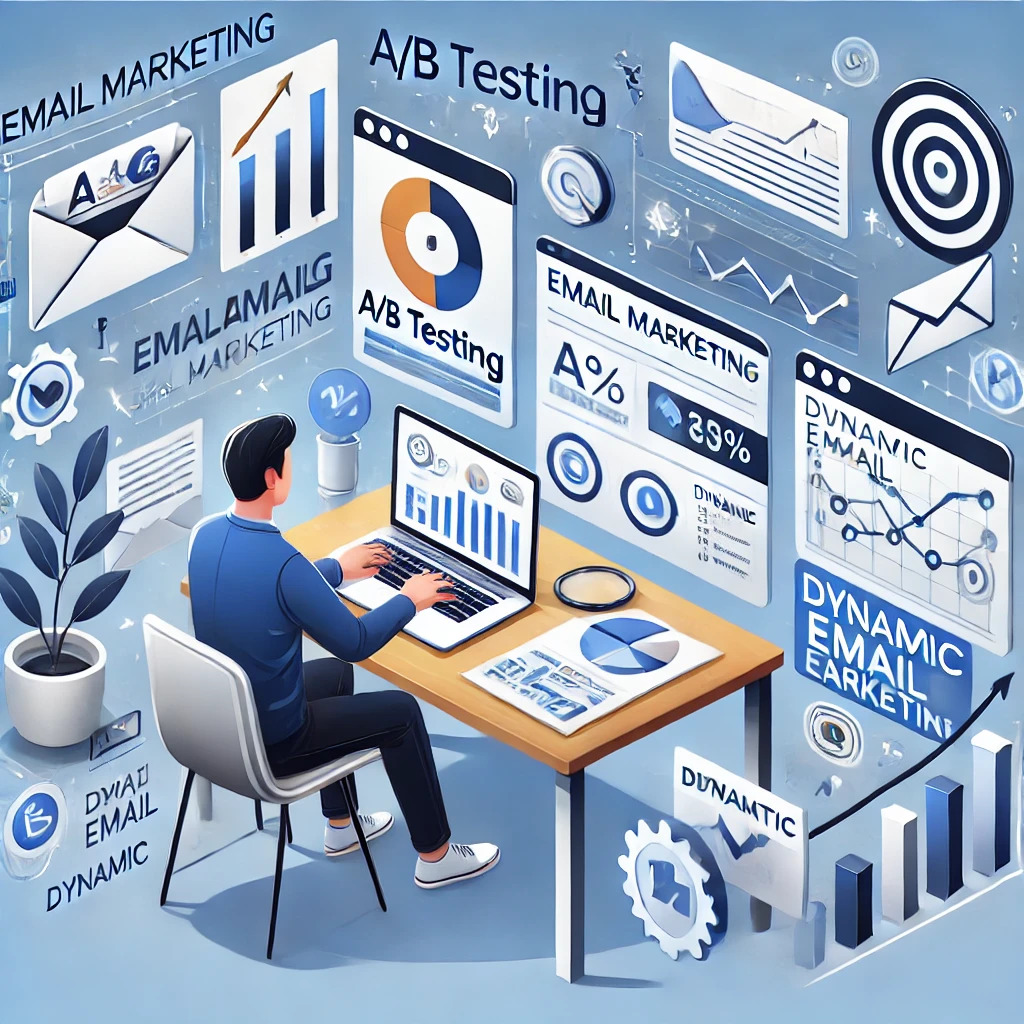Email marketing is one of the most powerful tools available for businesses looking to engage with their audience and drive conversions. However, with inboxes flooded with countless emails every day, standing out requires more than just a catchy subject line. To truly succeed, marketers need to go beyond the basics of email marketing. Advanced techniques, including data-driven personalization, automation, and optimization through A/B testing, are essential for improving engagement, efficiency, and conversion rates. In this article, we’ll explore how leveraging customer data for personalized campaigns, automating email workflows, and analyzing key metrics through A/B testing can elevate your email marketing strategy to the next level.
Personalization Beyond the Basics: Using Data to Tailor Email Content

Personalization has become a cornerstone of successful email marketing. While basic personalization techniques, such as including the recipient’s name in the subject line, can increase engagement, today’s marketers need to go further. Advanced personalization, which leverages customer data and sophisticated techniques, can take your email campaigns to the next level, leading to higher engagement and conversion rates. Here’s how to effectively use data to tailor email content for your audience.
Leveraging Customer Data for Personalized Email Campaigns
The foundation of advanced email personalization lies in customer data. To tailor your content effectively, you must gather and analyze data points such as purchase history, browsing behavior, and demographic information. This data allows you to send highly relevant content that resonates with each recipient’s specific interests.
For example, by analyzing past purchases, you can send targeted emails with recommendations based on what customers have bought in the past. If a customer previously bought a pair of running shoes, you might suggest new running gear or accessories in future emails. This level of personalization makes the customer feel like you understand their preferences, leading to a higher likelihood of engagement and conversion.
Moreover, data-driven personalization extends to the timing of your emails. Analyzing customer behavior can tell you when a customer is most likely to engage with your emails, allowing you to send them at the optimal time. For instance, if you know a user frequently opens emails in the evening, you can time your campaigns to arrive when they’re most likely to read and act on them.
Techniques Like Dynamic Content, Behavioral Triggers, and Product Recommendations
Dynamic content is another powerful personalization technique. With dynamic content, you can create emails that adjust the message based on the recipient’s behavior or preferences. For example, the email template could show one set of products to a user who has previously purchased shoes and another set of products to a user who has browsed bags. This technique makes the email more relevant and increases the chances of conversion.
Behavioral triggers, such as cart abandonment emails or post-purchase follow-ups, are also crucial. For instance, if a customer adds an item to their cart but doesn’t complete the purchase, an automated email reminder with the product they left behind can help nudge them toward completing the transaction. These types of emails rely on real-time data and can significantly improve engagement rates.
Additionally, product recommendations based on customer behavior and preferences can be embedded into email campaigns. By analyzing what products a customer has shown interest in, you can recommend similar or complementary products, increasing both cross-sell and upsell opportunities.
The Impact of Segmentation and Targeting on Email Performance
Segmentation is key to effective personalization. By segmenting your email list based on factors such as location, purchase behavior, or engagement levels, you can send highly targeted emails that speak directly to the needs and interests of specific groups. For example, you can create different email campaigns for first-time buyers, repeat customers, or dormant customers, each with messages tailored to their stage in the customer journey.
Targeting specific segments allows for better email performance. For instance, sending a loyalty reward email to repeat customers or an exclusive offer to a VIP customer segment is more effective than sending a generic message to your entire list. By targeting the right audience with the right message, you increase the likelihood of conversions and build stronger customer relationships.
In conclusion, advanced personalization in email marketing is about going beyond basic techniques to create highly relevant, data-driven content. By leveraging customer data, using dynamic content and behavioral triggers, and focusing on segmentation and targeting, you can create email campaigns that speak directly to your audience’s interests, leading to higher engagement and conversion rates.
Automating Email Campaigns for Increased Efficiency and Engagement

Email marketing automation is one of the most powerful tools available to businesses looking to increase efficiency while maintaining personalized engagement with their audience. By automating email sequences, marketers can deliver the right message to the right person at the right time, significantly improving customer experience, boosting conversions, and saving valuable time. Here’s how to set up automated email campaigns and maximize their effectiveness.
Setting Up Automated Email Sequences: Welcome Emails, Cart Abandonment, and Re-Engagement Emails
Automated email sequences are a set of pre-scheduled emails that are sent based on specific actions or timelines. Some of the most common automated email campaigns include welcome emails, cart abandonment emails, and re-engagement emails.
- Welcome Emails: These are the first emails a subscriber receives when they join your mailing list. A well-crafted welcome email sets the tone for the relationship with your audience. It’s an opportunity to introduce your brand, set expectations for future communications, and offer a warm welcome with special discounts or valuable content. Automated welcome emails have high open rates, making them an essential part of your email strategy.
- Cart Abandonment Emails: One of the most effective automated sequences is triggered when a customer adds items to their cart but doesn’t complete the purchase. Cart abandonment emails remind the customer of the items they left behind and encourage them to complete their purchase. These emails often feature product images, urgency-inducing copy, and sometimes a discount to entice customers to return and complete their transaction.
- Re-Engagement Emails: Over time, some subscribers may lose interest or become inactive. Re-engagement emails are designed to win back these customers by offering incentives, showcasing new content or products, or simply reminding them of the value your brand provides. These emails can be triggered based on a specific period of inactivity and are crucial for maintaining a healthy, engaged email list.
Using Triggers and Workflows to Deliver the Right Message at the Right Time
Triggers are actions or events that prompt automated emails. By setting up specific triggers, marketers can send messages based on user behavior or interaction with the brand. For instance, if a customer opens an email but doesn’t click on a link, a follow-up email can be triggered, offering more relevant content or a special offer.
Workflows are a series of automated emails that are sent based on a trigger and follow-up actions. For example, a welcome email sequence could include a series of three emails sent over the course of a week—each one introducing different aspects of your business, offering useful information, and inviting the customer to take the next step. By carefully planning workflows, you can ensure that your emails follow a logical progression and that the message stays relevant as the customer journey evolves.
Best Practices for Timing and Frequency in Automated Emails
The timing and frequency of automated emails are key to their success. Too many emails in a short period can overwhelm subscribers and lead to unsubscribes, while too few can cause your brand to be forgotten.
- Timing: Email campaigns should be timed to align with customer behavior and preferences. For example, cart abandonment emails should be sent shortly after the cart is abandoned—ideally within an hour or two—while re-engagement emails may work best after a few weeks of inactivity. Also, consider time zones and sending emails when your audience is most likely to check their inbox.
- Frequency: A good rule of thumb is to send emails at a steady pace that keeps your brand top of mind without overwhelming your subscribers. For instance, welcome emails can be spaced out over several days, while cart abandonment emails should be sent quickly, and re-engagement emails can follow a less frequent schedule to rekindle interest without seeming intrusive.
By fine-tuning the timing and frequency of your automated emails, you can ensure that your messages are impactful and appreciated, not overwhelming.
In conclusion, email automation not only saves time but also allows you to deliver targeted and personalized messages that enhance customer experience. By setting up automated sequences, utilizing triggers and workflows, and optimizing timing and frequency, businesses can increase engagement, drive conversions, and build lasting customer relationships.
A/B Testing and Analytics: Optimizing Email Performance for Better Results

Email marketing is an ever-evolving landscape where small adjustments can lead to significant improvements in performance. A/B testing and data analytics are powerful tools that enable marketers to optimize email campaigns, boost engagement, and ultimately drive better results. By testing various elements of your emails and analyzing key metrics, you can refine your strategy for maximum impact. Here’s how A/B testing and analytics can help optimize your email performance.
The Importance of A/B Testing for Subject Lines, Copy, Design, and CTAs
A/B testing (or split testing) is the process of comparing two versions of an email to determine which performs better. This technique allows you to test different elements of your emails, including subject lines, copy, design, and calls-to-action (CTAs). By experimenting with these components, you can identify which variations resonate most with your audience.
- Subject Lines: The subject line is the first thing recipients see, and it heavily influences whether they open the email. A/B testing subject lines involves tweaking language, length, and urgency. For instance, testing a subject line like “Limited Time Offer: 20% Off!” versus “Get Your 20% Discount Today” can show which phrasing drives more opens.
- Copy: The content of your email is essential for engagement. A/B testing copy can involve experimenting with different tones (formal vs. casual), message length, or the inclusion of personalized content. For example, testing a direct and straightforward message against a more conversational tone can reveal what your audience responds to more positively.
- Design: Design elements like images, layout, and colors can have a huge impact on how your email is received. Testing different templates, image placement, or button sizes can give you insights into what captures attention and drives interaction.
- CTAs: The call-to-action is one of the most important elements of an email. Testing different wording, button styles, or CTA placement (e.g., at the top or bottom of the email) can help you determine which version leads to more conversions.
Key Metrics to Track and Analyze
A/B testing provides valuable insights, but to refine your email campaigns effectively, it’s crucial to track and analyze key performance metrics. Here are some essential metrics to monitor:
- Open Rates: This is the percentage of recipients who open your email. Tracking open rates helps you understand how well your subject lines are performing. If open rates are low, it might indicate that your subject lines aren’t compelling enough or that your audience isn’t finding your emails relevant.
- Click-Through Rates (CTR): This metric tracks the percentage of recipients who clicked on a link within your email. CTR indicates how effective your email copy and design are at encouraging readers to take the next step, such as visiting your website or purchasing a product.
- Conversion Rates: Conversion rates measure how many email recipients completed a desired action, such as making a purchase or filling out a form. This is one of the most important metrics, as it directly impacts your return on investment (ROI). By analyzing conversion rates, you can identify the most effective CTAs and optimize your email campaigns for better results.
How to Use Data Insights to Continually Refine and Improve Email Campaigns
Once you have collected data through A/B testing and tracked key metrics, the next step is using those insights to refine and improve your email campaigns. For example, if your A/B test shows that a certain subject line leads to higher open rates, incorporate that subject line formula into future campaigns. If your click-through rates are low, consider revising your CTA language or making the CTA button more prominent.
Furthermore, ongoing analysis helps you understand your audience’s preferences, such as the types of content or offers they engage with most. By continually testing, analyzing, and optimizing based on data, you can improve the performance of your email campaigns over time, driving higher engagement and conversions.
In conclusion, A/B testing and analytics are crucial for optimizing email performance. By testing different email elements, tracking key metrics, and using data insights to refine your strategy, you can ensure that your email campaigns are consistently improving and delivering better results.
Conclusion
In conclusion, advancing your email marketing strategy through personalization, automation, and data-driven optimization is key to maximizing its effectiveness. By using customer data to tailor content, setting up automated workflows that engage your audience at the right moment, and continually refining campaigns through A/B testing and analytics, you can ensure your email marketing efforts yield better engagement and higher conversions. These techniques not only improve the overall customer experience but also streamline your efforts, allowing you to focus on delivering relevant and timely messages that resonate with your audience. Implementing these advanced email marketing practices will undoubtedly drive long-term success and growth for your business.

